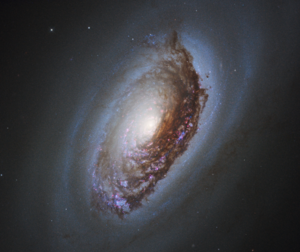| Black Eye Galaxy[1] | |
|---|---|
 Image taken by Hubble Space Telescope, March 14, 2020 | |
| Observation data (J2000 epoch) | |
| Constellation | Coma Berenices[2] |
| Right ascension | 12h 56m 43.696s[3] |
| Declination | +21° 40′ 57.57″[3] |
| Redshift | 0.001361±0.000013[4] |
| Heliocentric radial velocity | 410[5] |
| Galactocentric velocity | 400±4[6] |
| Distance | 17.3 Mly (5.30 Mpc)[5] |
| Group or cluster | CVn I[7] |
| Apparent magnitude (V) | 8.52[8] |
| Apparent magnitude (B) | 9.36[8] |
| Characteristics | |
| Type | (R)SA(rs)ab,[4] HIISy2 |
| Size | 16.51 kiloparsecs (53,800 light-years) (diameter, 25.0 mag/arcsec2 B-band isophote)[9] |
| Apparent size (V) | 10.71 × 5.128 arcminute[10] |
| Other designations | |
| Evil Eye Galaxy, M64, NGC 4826, PGC 44182, UGC 8062[10] | |
The Black Eye Galaxy (also called Sleeping Beauty Galaxy or Evil Eye Galaxy and designated Messier 64, M64, or NGC 4826) is a relatively isolated[7] spiral galaxy 17 million light-years away in the mildly northern constellation of Coma Berenices. It was discovered by Edward Pigott in March 1779, and independently by Johann Elert Bode in April of the same year, as well as by Charles Messier the next year. A dark band of absorbing dust partially in front of its bright nucleus gave rise to its nicknames of the "Black Eye", "Evil Eye", or "Sleeping Beauty" galaxy.[11][12] M64 is well known among amateur astronomers due to its form in small telescopes and visibility across inhabited latitudes.
This galaxy is inclined 60° to the line-of-sight and has a position angle of 112°.[7] At the distance of this galaxy, it has a linear scale of 65 ly (20 pc) per arcsecond.[7] The morphological classification in the De Vaucouleurs system is (R)SA(rs)ab,[4] where the '(R)' indicates an outer ring-like structure, 'SA' denotes a non-barred spiral, '(rs)' means a transitional inner ring/spiral structure, and 'ab' says the spiral arms are fairly tightly wound.[13] Ann et al. (2015) gave it a class of SABa,[14] suggesting a weakly barred spiral galaxy with tightly wound arms.
M64 is a type 2 Seyfert galaxy[15] with an HII/LINER nucleus. The central region is a weak source of radio emission.[7] A soft X-ray source has been detected at the nucleus, which is most likely coming from the circumnuclear region rather than directly from an active galactic nucleus.[16] There is an inner disk of molecular gas that is truncated at a radius of 2,300 ly (700 pc). At present, the non-rotational motions of this disk do not significantly feed the core, but the disk does produce a vigorous rate of star formation, with also approximately 100 billion stars inside the galaxy.[11] There is also evidence of a recent large inflow of mass.[17]
The interstellar medium of Messier 64 consists of two counter-rotating disks that are approximately equal in mass.[18] The inner disk contains the prominent dust lanes of the galaxy. The stellar population of the galaxy exhibits no measurable counter-rotation.[19] Possible formation scenarios include a merger with a gas-rich satellite galaxy in a retrograde orbit, or the continued accretion of gas clouds from the intergalactic medium.[18][19] It has a diameter of 16.51 kiloparsecs (53,800 light-years).[9]

- ^ Cite error: The named reference
tonryetal2001was invoked but never defined (see the help page). - ^ Cite error: The named reference
sinnott1988was invoked but never defined (see the help page). - ^ a b Cite error: The named reference
Skrutskie2006was invoked but never defined (see the help page). - ^ a b c Cite error: The named reference
vaucoulerus1991was invoked but never defined (see the help page). - ^ a b Cite error: The named reference
Tully2016was invoked but never defined (see the help page). - ^ Cite error: The named reference
nedwas invoked but never defined (see the help page). - ^ a b c d e Cite error: The named reference
Israel2009was invoked but never defined (see the help page). - ^ a b Cite error: The named reference
Paz2007was invoked but never defined (see the help page). - ^ a b "Your NED Search Results". ned.ipac.caltech.edu.
- ^ a b Cite error: The named reference
simbadwas invoked but never defined (see the help page). - ^ a b "Messier 64 - M64 - Black Eye Galaxy (Spiral Galaxy) | freestarcharts.com". freestarcharts.com. Retrieved 2020-06-07.
- ^ Rubin, Vera C. (January 1994). "Kinematics of NGC 4826: A sleeping beauty galaxy, not an evil eye". The Astronomical Journal. 107: 173. Bibcode:1994AJ....107..173R. doi:10.1086/116842. ISSN 0004-6256.
- ^ Cite error: The named reference
deVaucouleurs1963was invoked but never defined (see the help page). - ^ Cite error: The named reference
Ann2015was invoked but never defined (see the help page). - ^ Cite error: The named reference
Malkan2017was invoked but never defined (see the help page). - ^ Cite error: The named reference
Grier2011was invoked but never defined (see the help page). - ^ Cite error: The named reference
Burillo2003was invoked but never defined (see the help page). - ^ a b Cite error: The named reference
1992Nature360,442was invoked but never defined (see the help page). - ^ a b Cite error: The named reference
1995ApJ438,155was invoked but never defined (see the help page).